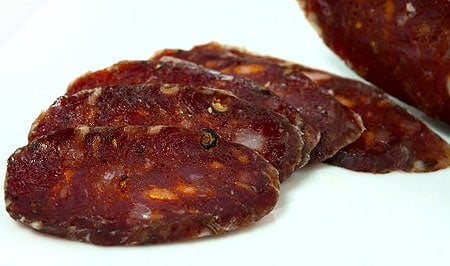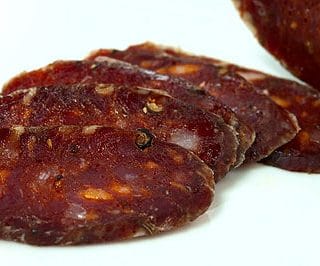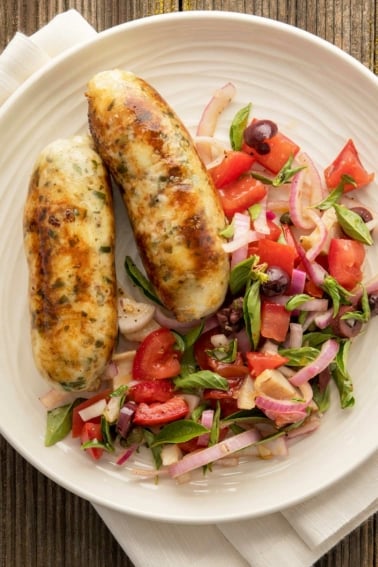As an Amazon Associate I earn from qualifying purchases.

I am a big fan of easy-to-eat salami. I grew up eating Slim Jims, and thin salami you can carry along with you are a real treat on the road or in the field; we love to eat them in the duck blind in winter.
As far as salami goes, this cacciatore salami is pretty easy. It uses standard hog casings instead of beef casings, which can be tough to find. The wider beef casings are more challenging to cure, too. These thinner salami can cure in as little as 2 weeks, although a month is better.
Note that if you have a choice of hog casing widths, you want slim ones, not the fattest available. I use these.
The flavorings here make a powerfully spiced salami. You can pare them back if you want, or change them any way you wish — only don’t mess with the salt, curing salt, dextrose or sugar, and black pepper.
You also will need a few things before you even start:
- Curing salt No. 2, and a special bacterial starter that ensures the good bugs beat the bad ones.
- A humidifier, or a place where the humidity can reach 85 percent.
- A place to hang your sausages in this humid environment.
- A place to hang your sausages after the initial ferment, preferably a place with humidity about 70 to 80 percent and about 50 to 60°F.
- Hog casings, which are available at any good supermarket (ask the butcher) or in a butcher’s shop.
Make your cacciatore salami with pork (wild or farmed), venison or beef. You could use other animals, but be sure to read this article on the possibility of trichinosis in wild game first. No one wants to get a parasite.
If you’ve never made a salami before, start by reading my recipe for basic salami, and go from there. Salami-making is an advanced skill, so newbie sausage makers beware: Salami involves cured raw meat, and sanitation and strict adherence to salt content, nitrate and starter culture is vital. I am serious. If you screw around with the ratios in here mindlessly, you can get yourself very sick.
That said, this is not rocket science. And it’s a great salami to learn and master.
Ingredients
- 4 pounds pork, venison or wild boar
- 1 pound pork fat
- 51 grams (about 3 tablespoons) kosher salt
- 10 grams (1 tablespoon) sugar or dextrose
- 6 grams (about a teaspoon) Instacure No. 2
- 1 tablespoon garlic powder
- 2 teaspoons caraway seed
- 1 tablespoon ground coriander seed
- 2 tablespoons ground black pepper
- 1 teaspoon cayenne
- 3 tablespoons sweet paprika
- 5 grams (about 1 tablespoon) starter culture T-SPX
- 1/3 cup distilled water
- 1/4 cup red wine
Instructions
- Chop the meat and fat into 1-inch chunks. Remove as much silverskin and gristle as you can from the pork. Mix the meat and fat with the salt and the Instacure No. 2 and grind through a coarse die; I use 10 mm. Put in the fridge in a covered container overnight.
- The next day, put about 10 feet of hog casings into some warm water and set aside.
- Mix all the spices and sugar with the meat and fat. Chill for 1 hour in the freezer, then grind through a medium die, about 6 mm. Note, if you've already ground the meat through a die this small, grind only half of it. Check the temperature of the meat: If it's 35°F or colder, grind half of the mixture through a fine die; I use a 4.5 mm die here. If the meat mixture is warmer, freeze it until it hits the right temperature and then grind. Either way, put the meat into the freezer while you clean up and get ready to stuff the links.
- Run warm water through your hog casings while the meat is chilling. This flushes them, and will show you any leaks in the casings. Set them back in the warm water when you’re done.
- Also while you are waiting for the meat to chill, get your starter culture ready. Gently mix the starter culture with the distilled water and let it sit for at least 15 minutes.
- Once the meat is 32°F or colder, put it in a large bin. Add the wine and starter culture and mix everything well with your (very clean) hands for a solid 2 minutes. Your hands should ache with cold as you do this. Alternately, put the mixture into the bowl of a stand mixer fitted with the heavy paddle attachment. Mix everything on the lowest setting for 60 to 90 seconds. Either way. you will see the meat change texture: it will bind together and stick to itself.
- Put the meat into your sausage stuffer and stuff it into the hog casings. Twist off into links of about 8 inches. Twist off your links (Here's a quick video on making the links) or tie off each link with kitchen twine. As you do this, use a needle or sausage pricker (Heat the tip of the needle over a flame until it glows; this sterilizes it.) and prick out any air pockets in the links. Do this gradually and gently or you will rupture the casing. This takes some practice.
- Hang the links on a drying rack — a wooden clothes drying rack is excellent for this. Now you need to ferment the sausage. You will want to tent the hanging sausages with black plastic from some garbage bags, or some other plastic sheeting. If you have one, put a humidifier under the sausages. You really want them to stay moist. Let the sausages hang for at least 36 hours, and up to 48 hours. Every 6 to 8 hours, spritz them with a spray mister to keep them moist. This is the fermentation stage, the stage where the starter culture you are using defeats any bad bacteria in the sausage.
- When the sausages are ready, hang them in your drying chamber. I use an old fridge with a temperature regulator and a humidifier in it. Hang the links at about 70 to 80 percent humidity for at least 2 weeks before eating. You can let them go as long as 6 weeks. Store in the fridge, or vacuum sealed in the freezer.
Nutrition
Nutrition information is automatically calculated, so should only be used as an approximation.





When you say red wine, what type of wine are we going for? A sweet wine or a stronger tasting wine? Could you give me a couple of brands to use please. Thanks
Daniel: A regular red, like a Chianti or barbera or merlot. Nothing too dark like Amarone or petit verdot.
I really think this sausage looks delicious and I plan to make it when my current project (it’s an example of a sujuk which is curing now) is almost finished being eaten. I’m toying on using beef chuck. Any input you or anyone else would add would be appreciated.
Do you know where I can buy starter culture? I have two shoulders coming this Saturday and my son and I plan on going with your recipe.
Thanks
Bill: Online at The Sausage Maker.
What happens if you don’t use the the starter culture. I’ve made sausage for a few years and always just used salt and instacure.
am I risking my life?? Ha. or is it more of a tradition/flavor thing?
Don: It is a safety thing, but you can make salami without a starter culture. It’s just riskier — mostly in terms of a failed batch. It is my understanding that you would notice a spoiled batch. It has ever happened to me, but I always use starter.
You call for 1 tablespoon of tspx, the package of tspx says one half teaspoon for every 5 lb of meat, who should I believe?
Please let me know.
Thanks
Alf bergkvist
Alf: Me. Those amounts are for professionals, and are the minimum. I err on the high side of starter because it is vitally important that you have enough in your small batch to properly inoculate the meat.
It’s NOT 4 lb of meat there is 1lb of fat so the t Sox is spot on.
Read the directions, I made this and it’s super.
Love the ingredients on this recipe! However, 10 grams of T-SPX for 4 pounds of meat seems to be a little too much, doesn’t it? CHR Hansen’s recommendation is 25 grams for 200 kg (around 400 pounds). Unless you really want it extra extra extra fermented (I mean crazy fermented)… maybe I am missing something here, but the amount of T-SPX really called my attention… Thanks for sharing!
What pork cut from the store is best for cacciatore? Also, where do you suggest grabbing a ball of pork fat? Do they sell it like that? Thanks for your outstanding info.
Rudy: Pork shoulder. If you get it fatty enough, you won’t need fatback. And it’s not sold in balls, but in slabs, typically frozen.
At what temperature do you maintain when using the drying rack
Mike: Around 50 to 55 degrees Fahrenheit.
I ended up using venison, moose and pork. It took five weeks to get to 43% weight loss. The taste is amazing. Thanks, Hank!
I will dump it for safety sake and start all over again. Thanks
Is it normal for the links to smell real bad while they are hanging in the drying chamber.
Jerry: No.
Why is the recommended dosage of starter culture so much lower on the packet instructions? It says that 25g is good for 400+ lbs., but your recipe uses 10g for 5lbs. Just wondering. Thanks for what you’re doing.
Rocky: Because I am erring on the side of safety. That package is meant for commercial batches, which use commercial mixers. I use more so you are sure to have a safe amount of starter in your home version. It does no harm, and too little can indeed be dangerous.
I was looking for salami recipes and, not surprisingly, yours popped up first. My plan is to use three pounds of ground venison, one pound of pork shoulder on a medium grind, and coarse grind the fat. I’ve not been able to clear space for a curing chamber yet, so I’ll be using the UMAi 50mm Salumi Dry Bags.
Thanks for another great recipe, Hank!
Thanks
If one of the ends of the Links going comes untied during the initial fermentation can I retire or should I throw it away.
Jerry: You can re-tie it.
Hi Hank,
You list using t-spx starter culture for the recipe and that it could be ready in two weeks. Would F-RM-52 be a better culture to have this ready in a couple weeks? BTW….outstanding website and books!!
I am making the Cacciatore Salami and I have a question. Does the pork fat have to be all fat or can it have lean in it too.
Thanks
Jerry
Jerry: If you are doing 4 pounds lean wild game meat and 1 pound fat, it needs to be all fat. If you have some lean, i.e., fatty pork shoulder, go 3 pounds lean game and 2 pounds pork shoulder.
Read the part about things needed. Im thinking 50-60 degrees F is what it’s spose to be. Maybe?
what temp dose the fridge need to at for 2 weeks I understand the 70 80 humidity